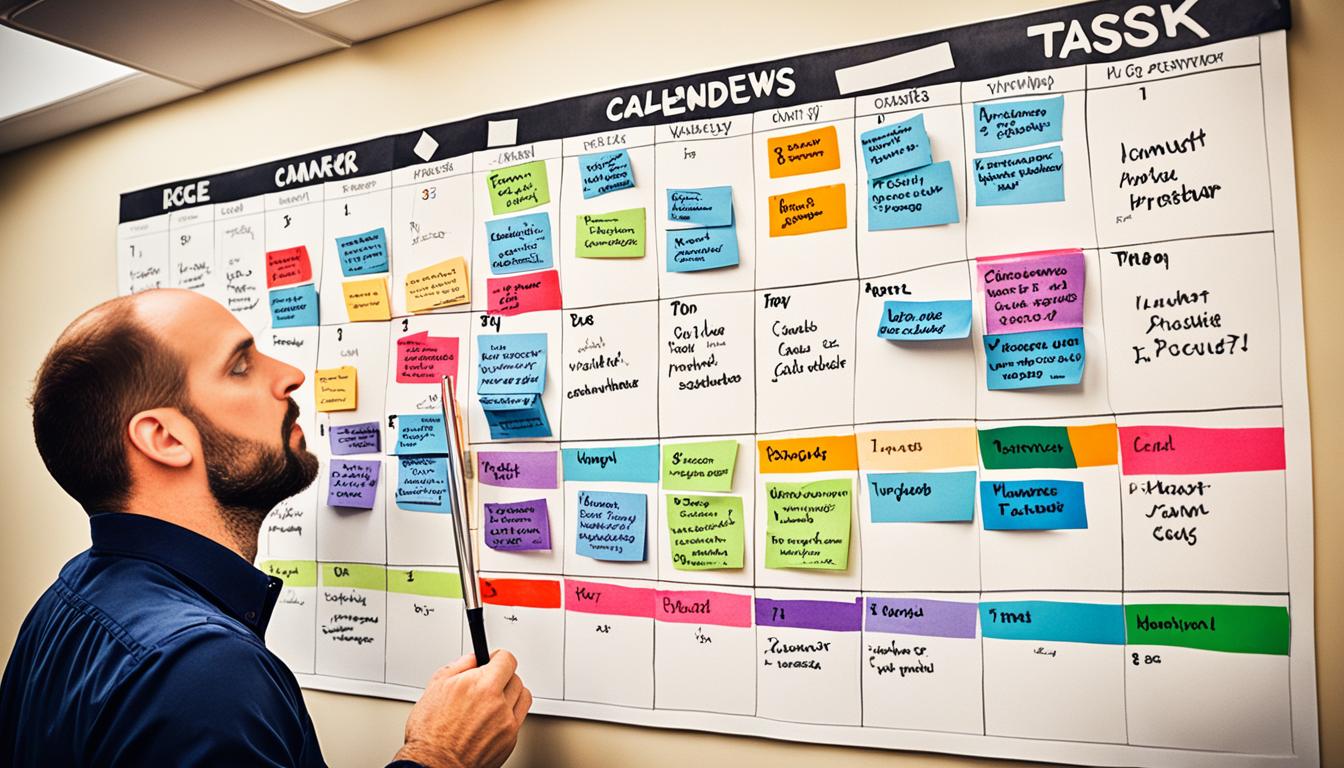A well-managed hourly calendar boosts weekly schedule and daily productivity. It helps break tasks into smaller parts. This makes it easier to set priorities and hit goals.
Studies show that writing down goals can help you reach them by 42%. Using a daily or weekly planner lowers stress. It also helps you handle unexpected events better.

Planners also help with a better work-life balance. By knowing when you work best, you can save time for fun activities. This way, you manage your work and meet deadlines well.
This leads to less stress and more happiness. With the right tools, employees can be 20% more productive.
Key Takeaways
- Individuals only spend half of their work hours on work-related tasks.
- Writing down goals increases the chances of achieving them by 42%.
- Daily or weekly hourly planners effectively reduce stress.
- Planners foster a healthier work-life balance by prioritizing productive hours.
- Engaged employees using proper scheduling tools see a 20% productivity boost.
Introduction to Hourly Planning
Hourly planning is key to an effective scheduling strategy. It helps people and teams use their time well. A schedule is a must-have for businesses. It shows work days, times, and who does what. This makes sure everyone is treated fairly and works together better, making teams happier and more productive.
There are planner templates you can download in Word, Excel, and PDF. You can change them to fit your needs. They have things like a to-do list, a timeline, and a water tracker. These features help you stay organized and meet deadlines.

There are planners for daily, weekly, and hourly plans. They look good and help you keep track of your schedule. By planning your tasks, you can handle your day better and feel less stressed.
People in different fields like event planning and video production find hourly planning very useful. The planners are fully editable and can be used with tools like Google Calendar. This makes planning easy and flexible.
These planners come in different sizes and styles. They have daily and weekly templates for various needs. You can choose between Monday and Sunday starts, making them very flexible.
They have special features like task priorities and essential tasks. These planners help you plan your day well. You can use them in digital apps like Goodnotes, making them very useful.
Template FeatureFormats AvailableCustomizationDaily, Weekly, and Hourly PlanningPDF, Word, ExcelFully editableMonthly Calendar PrintablesPDF, PNG, JPEGUndated, customizableHabit Tracker FilesPDF, PNG, JPEGCustom resizing available
Boosting Productivity Every Day
Using hourly calendars can make daily work better. It helps focus on what’s most important, cut down on distractions, and manage tasks well. This way, people can make the most of their work hours.

Prioritization of Tasks
Putting tasks in order means tackling urgent and key activities first. This can really help increase daily productivity. Using the MIT method, where you pick 1-3 main tasks each day, makes managing work easier.
Cal Newport says that planning your day can be as effective as working long hours. A structured 40-hour week can do as much as a long, unorganized week.
Minimizing Time Wasters
It’s important to cut out things that aren’t needed to focus better. The Pomodoro Technique, with its 25-minute work and short breaks, helps you do more in less time. Paul Klipp found that focused work in 50 minutes is better than a long, unorganized day.
Working in 90-minute blocks can also boost productivity. This matches tasks with your natural energy cycles.
Efficient Task Management
Hourly calendars help put resources where they’re needed most and keep focus on important tasks. The 90-minute focus method, with work and rest breaks, fits tasks with your energy levels. This way of planning makes you more efficient and gives you a sense of achievement at the end of the day.
Enhancing Time Management Skills
Effective time management is key to maximizing efficiency and reaching goals. Using hourly planning helps people manage their time better for both short and long goals. Keeping a time log by tracking activities in 15-minute intervals for a week or two helps a lot. This way, you can spot and cut out time-wasters, boosting your productivity.
Scheduling tasks is vital for setting goals and making sure important tasks get enough time. Think about when you work best and use those hours for big tasks. This way, you work hard when it matters most. Also, planning for surprises helps you stay on course even when things don’t go as planned.

Getting better at time management means putting tasks in order. Make a “to-do” list with high, medium, and low-priority items to focus on what’s key. Clutter can hurt your well-being, so staying tidy is crucial. Using a system to organize emails can also save time and make checking emails easier.
Using apps like time trackers and task managers can really help with maximizing efficiency. Also, giving tasks to others can free up your time for what you’re best at. Fighting off procrastination is key; break big tasks into smaller bits and reward yourself for each step.
To see the benefits, look at these stats:
StatisticDetailEnhanced Productivity60% of students reported increased productivity by assigning specific tasks to designated time slots for hourly planning.Improved Time Awareness75% of students noticed improved time awareness after adopting hourly planning methods.Reduction in ProcrastinationHourly planning led to a 50% decrease in procrastination among students.Task Prioritization85% of students found hourly planning effective for prioritizing tasks based on importance and deadlines.Balanced LifestyleStudents practicing hourly planning saw a 70% rise in a balanced lifestyle, integrating academic pursuits with personal interests and relaxation.Digital Tools Utilization90% of students recommended using tools like Google Calendar, Microsoft Outlook, Apple Calendar, MyStudyLife, and Todoist for effective hourly calendar management.
Achieving Better Work-Life Balance
Finding the right balance between work and personal life is hard for many today. An hourly planner helps bridge the gap between work and personal life. This leads to more control and freedom.

Integrating Personal and Professional Life
Working and living together is key for happiness. People check their email 36 times an hour, causing distractions. To fight this, set times for emails and meetings.
This lets you focus on work and personal stuff. Having set times for tasks helps balance work and rest. This is key for growing in your job and staying happy.
Allocating Time for Self-Care
Americans miss 375 million vacation days a year, but taking care of yourself is important for staying productive. An hourly planner helps you plan breaks, following the 52/17 rule and the Pomodoro Method.
Setting aside hours for rest, exercise, and family time boosts your well-being. This way, taking care of yourself doesn’t hurt your job. It helps you grow in your career without hurting your mental health.
Here’s a detailed table showing how to mix different activities in a day:
ActivityRecommended TimeBenefitsEmail Checking3x15 mins/dayReduces distractionsMeetings2 hours/dayFocuses on necessary discussionsFocused Work3x90 mins blocksEnhances productivityBreaks17 mins for every 52 minsBoosts mental relaxationExercise1 hour/dayImproves physical healthFamily Time2 hours/dayFosters relationships
Review and adjust your planner often to stay on track. This helps you manage work and personal goals well. It leads to a balanced life.
Strengthening Accountability
Building accountability in a team or for yourself is key to staying productive and hitting deadlines. Hourly calendars help by setting clear tasks and times to finish them. They make it easy to see progress and work together as a team.
Tracking Progress
Using an hourly calendar makes tracking progress easy and clear. It lets people and teams mark tasks as done. This way, you can see how much you’ve done and stay on track with your goals.
![]()
Tools like daily schedule templates in Google Sheets help with accountability. They have important parts like start times, how long tasks take, what they’re about, and a spot for notes. They’re great for tracking progress, whether it’s for work or school.
Task Ownership
When team members own their tasks, they work harder and together better. An hourly calendar makes it clear who does what and keeps track of progress. This makes everyone feel more responsible and proud of their work.
Using tools like Asana’s daily schedule templates helps teams stay on top of their work. It makes everyone take their tasks seriously. This leads to better teamwork and makes sure all tasks are done, helping everyone work towards the same goals.
Studies show that doing a weekly review can make you 30% more likely to reach your goals. A weekly review helps people feel more in charge of their tasks. This boosts productivity and makes teams work better together.
Increasing Flexibility in Scheduling
Hourly planning lets workers adjust their schedules to fit their needs and work best. A big 79% of workers like to work from home at least once a week. They use hybrid schedules like working three days in the office and two days from home.

Flexible schedules let workers pick their days to work from home or the office. Part-time workers save money and stay with the company longer. They also get to join a bigger talent pool. This keeps workers happy and productive, cutting down on missing work and leaving the job.
Companies with flexible work hours see many benefits. They use special schedules to mix office and home work. This helps 80% of them work better and keep everyone in touch. Working from home first also saves money and brings in more talent.
Flextime has big perks like keeping workers happy and finding new ones. It can be tricky to plan and talk about work, but done right, it boosts work efficiency and keeps workers involved.
- Flexible hybrid schedules fit different worker needs.
- Part-time and remote-first plans draw in more talent.
- Good scheduling tools help manage work and talk better.
Surveys show how important flexible schedules are:
Work ArrangementPercentageBenefitRemote work at least once a week79%Employee preferenceOrganizations using hybrid schedules80%Operational efficiencyEmployees valuing flexible scheduling79%Improved satisfaction
Using flexible work plans and methods like dynamic planning and custom scheduling really helps. It makes work better and keeps workers happy.
Hourly Calendar for A Week: Structure and Discipline
Using an hourly calendar helps you stay disciplined. It makes you more focused and productive. It turns your week into a structured plan, making every moment count.
Setting Clear Boundaries
It’s important to have clear lines between work and personal life. An hourly schedule makes these lines clear. This stops you from working too much and makes sure you have time to rest.
Not everyone works best in an eight-hour day. An hourly calendar lets you adjust your work hours to what works for you. This way, you make fewer decisions and have a more predictable day.
Creating a Routine
Having routines helps you manage stress and keep a daily plan. You can customize hourly planners to fit your needs. This helps you focus on what’s important and stick to your schedule.
Being consistent is crucial. By setting habits in your routine, you make your day flow smoothly. This reduces worries about managing your time. Techniques like the Pomodoro Technique or the 52-17 rule can help you stay focused during work times.

Reducing Stress
An hourly calendar is great for lowering stress. It makes your work predictable and helps you stay on track. This reduces feeling overwhelmed.
Planning your hours can save you up to 10 hours of work a week, experts say. Proper planning and discipline lead to better results. This makes your daily life easier and less stressful.
Improving Overall Productivity
Using a structured schedule changes the game. It lets people focus on what really matters. This way, every minute is used well.
Scheduling helps prepare for tasks. It makes timing better and cuts down on mistakes. This makes work quality go up.
Using an hourly planning tool helps reach goals and find ways to save time. This method leads to finishing tasks better and getting better results. It makes people feel proud of what they do.
Having a schedule also helps plan personal stuff, which is good for your health. It’s important to plan for the future, like on Fridays. This keeps focus on important tasks and lowers stress.
Adding time management tools like time blocking and the Pomodoro Technique boosts energy and productivity. This makes reaching goals in work and life more rewarding.
FAQ
What are the benefits of using an hourly calendar for a week?
A weekly schedule with an hourly calendar boosts daily productivity. It helps manage time better and supports a good work-life balance. It also makes sure tasks are done on time.
How does hourly planning help with effective scheduling?
Hourly planning makes scheduling better by allocating time well. It uses productivity tools and makes sure important tasks get done fast.
How can prioritization of tasks boost productivity every day?
By focusing on urgent and important tasks first, daily productivity goes up. This makes work more efficient.
What techniques help in minimizing time wasters?
Getting rid of distractions and focusing on important tasks cuts down on time waste. This makes work more productive.
How does efficient task management work?
Good task management means using resources well and avoiding distractions. This leads to more work done and better task readiness.
What are the key elements of enhancing time management skills?
Improving time management skills needs good planning, clear goals, and constant efficiency. These are key to better time use.
How does hourly planning achieve better work-life balance?
Hourly planning combines work and personal life. It sets time for self-care. This helps with personal and professional growth.
How can integrating personal and professional life be effective?
Integrating work and life makes managing tasks easier. It reduces stress and increases happiness.
Why is allocating time for self-care important?
Self-care time for activities like exercise and family is crucial. It boosts personal well-being. This helps with better work performance and growth.
What role does strengthening accountability play in an hourly calendar?
Being accountable with an hourly calendar improves task management. It helps track progress, measure productivity, and boost teamwork.
How does tracking progress help in achieving goals?
Tracking progress shows clear results. It helps stay on target and improves productivity over time.
What is the importance of task ownership?
Task ownership makes people and teams more responsible. It motivates them to reach their goals. This leads to better teamwork and performance.
How does an hourly calendar increase flexibility in scheduling?
An hourly calendar offers flexible scheduling. It allows for changing work plans and personal needs. This makes resource planning easier.
What are the benefits of setting clear boundaries with an hourly calendar?
Setting work and rest boundaries is key. It reduces decision fatigue and leads to a healthier life with less stress.
How can creating a routine reduce stress?
A daily routine made with an hourly calendar reduces time worries. It helps maintain a steady work pace and lowers stress.
How does an hourly calendar for a week improve overall productivity?
An hourly calendar boosts efficiency and goal achievement. It helps manage daily and weekly tasks well, improving work quality.

More Posts
11 Budget-Friendly Team Lunch Ideas
Midday meals are key to keeping employees happy and productive. Studies show a 67% jump in job satisfaction with a meal program. Adding office lunch catering boosts company culture and work output. This guide offers...
14 Tips to Maximize Productivity with a Calendar Planner
Are you a tech aficionado who loves organizing every day of your life to enhance productivity? Or are you simply someone who loves making the most of everyday life? In the high pacing...
9 Books Entrepreneurs Should Read Until The Very Last Page
Building a company from the ground up is one of the hardest things. The odds are against you keeping in mind that 9 out of 10 new businesses fail. The learning curve is...
30 Games & Activities to Enhance Time Management
When you hear the term ‘time management’, your heart races. Sweat beads on your forehead. You feel a crushing sense of urgency. Time’s running away, and you’re chasing after it! We’re here to...